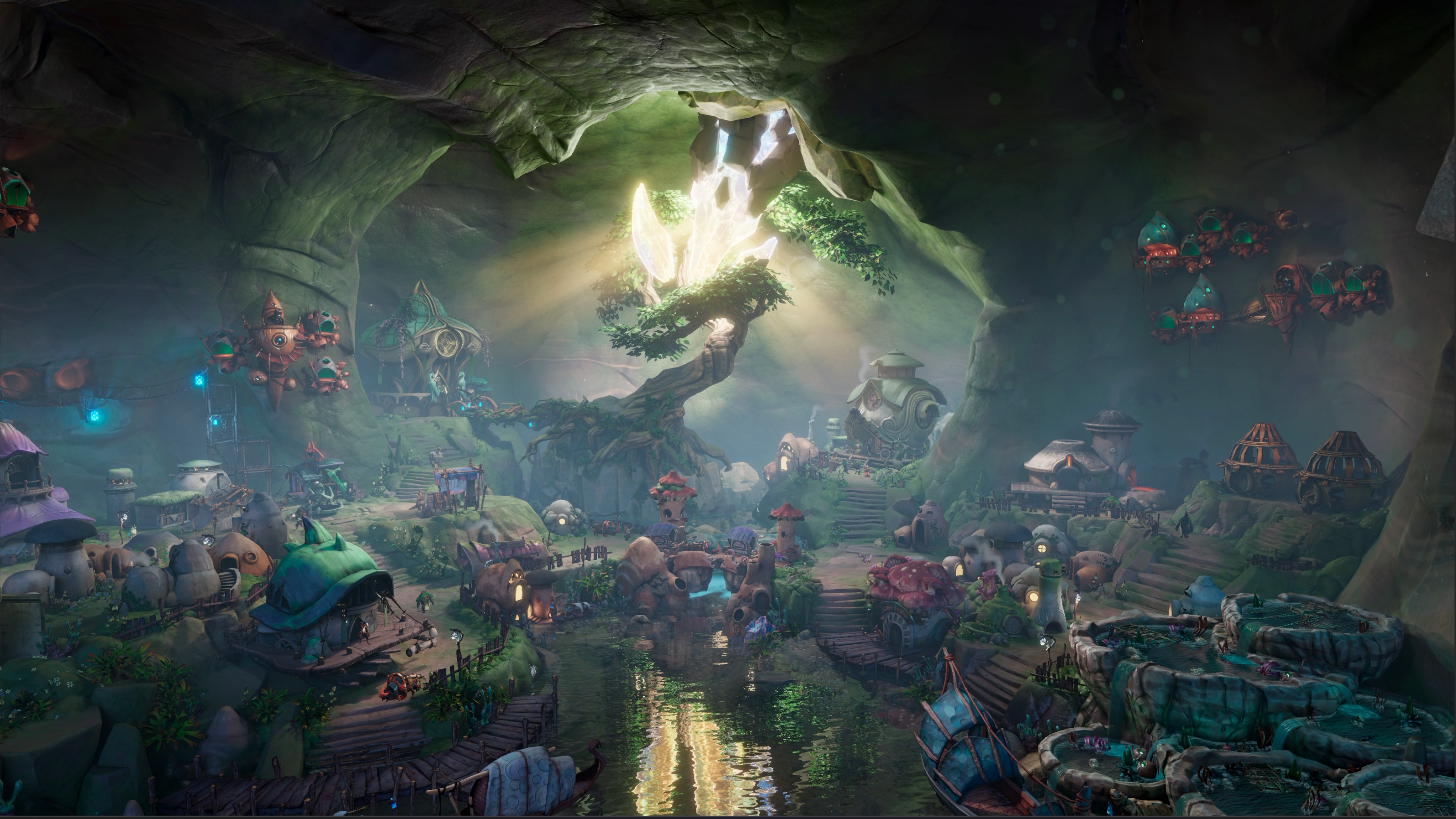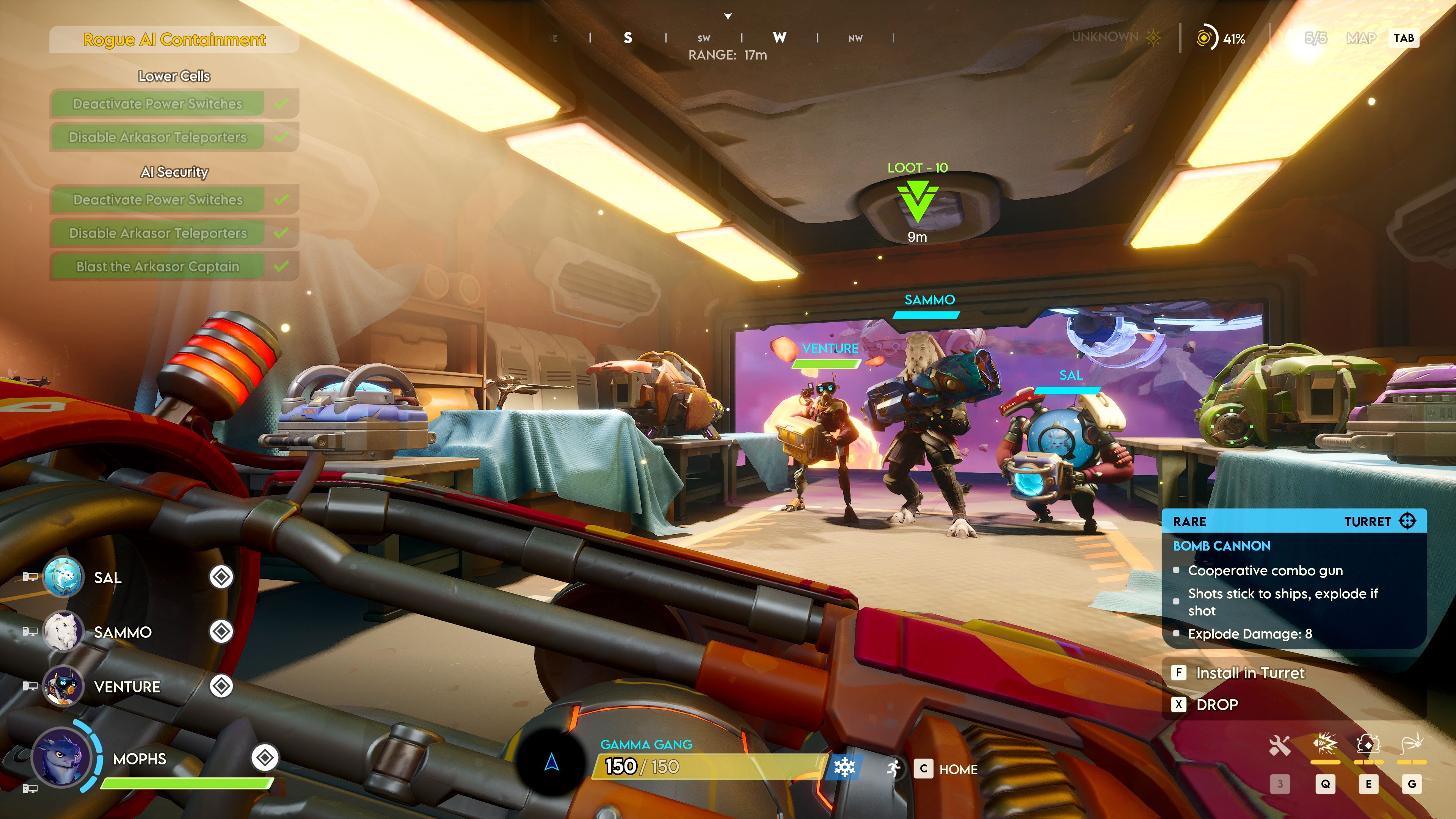At the Dreamhaven showcase, hosted by Geoff Keighley and Mike Morhaime, internal studio Moonshot Games pulled back the curtain on its team-based Sci-Fi game: Wildgate. The game focuses on delivering collaborative spaceship combat, finding ship upgrades, developing personal characters, and ultimately winning a match by acquiring the artifact and escaping or being the last crew still standing. The comparison is a little crude, but in so many ways, Wildgate earns all the accolades that “Sea of Thieves in space” evokes.
Ahead of the Dreamhaven showcase, Game Rant was able to spend a few hours playing Wildgate, and while the premise seemed like something I’ve heard plenty of times before (the artifact is from an ancient space civilization), Wildgate is undeniably fun. There is plenty of lore players will learn over time, as the game world is fully fleshed out from history to why players are fighting over the artifact, but my preview focused on gameplay. In short, each match features five crews, with each crew being composed of four players. Altogether, they venture out into a mysterious region of space known as The Reach in search of The Artifact. Ultimately, it is a PvEvP experience where other crews and the very environment puts constant pressure on a group to overcome and earn that victory by whatever means necessary.

Related
“The Game Master Is The Bridge”: Sunderfolk Team Talks Anjali Bhimani’s Role As The GM
Mobile-based cooperative RPG Sunderfolk features actress Anjali Bhimani as the Game Master, introducing the world and voicing multiple NPCs.
Heading Into The Reach
Before heading into The Reach, Wildgate players must party up. Navigating the menus is intuitive, and the primary choice is which Prospector to play. Character design in Wildgate is top-notch and leans into the alien fantasy of the genre. While it seems the game will eventually add human characters, the alien focus is refreshing in the Sci-Fi game space. Each character has their own backstory, which players can progress through the menu by playing and winning matches. This is also how players unlock new characters and their cosmetics. It does have a Battle Pass-like presentation, but it’s more a progression tracker than anything.
Players can choose their Prospector for their looks, with the axolotl-like creature in a tanksuit being an immediate fan favorite, or for their abilities. To be clear, though, this is not a hero shooter. While there are more hero shooters than ever, the characters of Wildgate simply have areas where they are better than others or may have a passive advantage. For example, the militant-looking alien with four arms is capable of damaging a ship’s hull himself, while the robot character doesn’t have to worry about oxygen when floating around space (which other characters can find pockets of in various locations).
Beyond that, players will unlock new weapons and be able to choose their loadout per match. There is an array of standard Sci-Fi weapons, expressed through rifles, snipers, and so forth, and other weapons like one that heals allies. Players can also select tools like grenades or traps. There’s everything players could really expect, with plenty of room to grow as the game does. The weapons are pretty standardfare for both a sci-fi and multiplayer game, but it’s the upgrades and items that players find in a match that are most interesting. For example, players can find a propulsion gun of sorts that makes flying around space much faster, aiding resource gathering or stealthy boardings.
Beyond that, players will also have a favorite ship that is fairly selected before heading into a match. These ships have slightly different stats, which could impact how players choose to play. Once players are ready and pop into a match, there is a small loading lobby where players can check a nearby monitor for environmental effects like thick asteroids. Players can jump around and mostly have fun in this lobby, while potentially identifying the ships associated with the various crews. Each ship has a name that is randomly generated and contributes to the fun of the game. For example, there was an enemy ship in one game called the Still Relevant. They played passively the entire time, and we couldn’t really find them, prompting a ton of dumb-fun puns and jokes about them being “Still Relevant.”
Running a Not-So-Tight Ship
Once in a match, players begin on their ship. It’s worth noting that when players leave it, whether to acquire resources or explore a nearby landmark, they are able to teleport back to it at any time (except when carrying The Artifact). There aren’t “defined” roles unless players want there to be, but there are plenty of ways for every player to interact with the ship itself. Someone needs to fly it, of course, and there are multiple cannons other players can man. There are numerous ways to upgrade those cannons and turn them into snipers, burst-shots, and so forth, as well as find and install upgrades to the ship (that could improve defenses or make the ship immune to environmental effects, for example). There are also probes players can use to find enemy ships, resources, the Artifact, or nearby locations.
In combat, fires can break out on the ship that’ll need extinguishing, while other ships and boarding players are constant threats. Other plays can bring bombs onto the ship that’ll need to be removed, or they can sabotage the ship’s core. There are tons of things opponents can do, meaning that players have to protect the inside and outside the ship at all times. The best way I can describe space combat in Wildgate is frantic, especially when there’s boarding involved.
Players will need to manage resources for the ship too: fuel, ice, and ammo. Without fuel, the ship can still fly but with far fewer tricks. Running out of fuel is a death sentence if players find themselves in combat. Without ice, players aren’t able to heal damage done to the ship, making it the most important resource in my mind. Using ice saved my crew from certain death more than once. And without ammo, well, my advice would be to not run out of ammo in a multiplayer game. Players are able to find fuel and ice from floating asteroids in space, where players will need to mine them, acquire the resource, teleport back to the ship, and deposit them.
With the basics established and players in a match, that’s where the fun begins.
To Fight or To Explore
As players fly around the map, there’s a lot to explore and do. Players can explore abandoned outposts or labs, for example, which could include a gauntlet run through alien NPC enemies like multiplying goos, a series of puzzles or environmental traps like lasers, and so forth. At the end, there is a lot of loot players can acquire to upgrade their ship or combat capabilities. What’s interesting is that these locations can also be stolen. At one point, my team found an enemy crew stationed at one of these explorables, and we attacked them. Another crew did the exact same thing as us, and understanding the position they were in, the original enemy crew fled. The second crew pursued them, but we broke away and went back to the outpost to find that the enemy crew had completed most of the objectives. We wrapped up the last one and pilfered their loot, better preparing us for future fights and fulfilling the space pirate fantasy.
With four players, it’s also worth looking at how players can divide and conquer. After losing one match because we ran out of fuel in a fight, I swore not to let us repeat that mistake, so while my crew completed activities around the map, I focused on loading us up on ice and fuel. We probably had way too much by the end of the match, but we won that one. There are a lot of viable approaches, including super aggressive ones. It’s entirely possible to go into a match, find other crews, and start attacking them. It’s possible to sneak around, focus on upgrades, and try to steal the match at the very end.
How each crew decides to play changes the entire dynamic of the game, and with the location of the artifact, the environmental threats, and all the explorable locations and loot being randomly generated, it seems fair to say that even a standard match of Wildgate is as dynamic as they come. There’s only this standard game mode for now and possibly for launch, but I am excited to see how Wildgate expands on this and LTMs in the future. I could see something like a Hot Potato game match, where whichever ship has The Artifact explodes at the end of the timer if they can’t get it onto another ship (probably with a smaller map) being tons of fun. I mean, Wildgate is just tons of fun at the end of the day, and it has so much potential in the cooperative/multiplayer game space that I can’t wait to see how Moonshot delivers on that potential.
Memorable Moments in Wildgate
Where Wildgate excels, with this perhaps extending to Dreamhaven as a whole, is creating memorable moments. My time with the game was brief, but it’s hard not to think of a few moments without smiling. In one of my first matches, we were the second ship eliminated after destroying the first and being third-partied. I’ve played enough Apex Legends to be well-acquainted with that feeling, but instead of returning to the lobby, my teammates and I continued to watch the match. Spectating, we were able to see a crew acquire the Artifact, which sends out a ping to the entire match. There is a timer in a match for when the “Wildgate” will open, which is what players with the Artifact need to escape through. They tried to make it there ahead of it opening, but two other ships closed in on them. Flying side by side in what appeared to be a gentleman’s agreement to focus on the ship with the Artifact (which does provide buffs to the holder), they were in hot pursuit and managed to destroy the other ship.
After that, one focused on trying to grab the Artifact from the destruction, while the other just turned on the enemy ship. That ship was the one that won, but watching it was entertaining the entire time, as we tried to figure out who was doing what, where everyone was, what the strategies were, and so forth. One of my teammates made a remark along the lines of “you know a game is fun to play if spectating a match is fun,” and I would agree. I was invested in the outcome of this Wildgate match, despite having been eliminated.
Another moment that draws a smile to my face was a creative victory. In a similar match, my crew ended up with the Artifact with two remaining enemy ships in hot pursuit. These two ships were staggered in a way that one reached us first, then the other. I wanted to avoid this situation because becoming the target is very hard to come back from, but we managed to win the first encounter. We only had a few moments to recover before the second crew began their attack. We tried to fly away and keep our distance since they had more health than us, but we managed to heal some damage dealt with ice while punishing them with our better weaponry. At one point, I called for us to deploy our minefield as we tried to create distance.
It was a great call because a teammate had the fantastic idea of using the tractor beam to drag the enemy ship into the mines, preventing the enemy from avoiding them. It worked and we won the match, which was exhilarating and speaks to the bonafide cooperative experience of Wildgate.
First Impressions of Wildgate
In general, I am a pretty quiet guy. I’ll communicate as needed in a multiplayer or co-op game if playing with people I don’t know, but I wouldn’t put that near the top of my preferred gaming experiences. I say all of this because, by the end of my first match, I had completely come out of my shell. That speaks to the quality of the people I was playing with at the time, which included a Moonshot Games dev, but also to the engaging cooperative experience of Wildgate. It may seem like a simple thing, but the fact that Wildgate naturally and actively had me laughing, communicating, and cooperating every game is high praise for anyone who knows me.
Twice now, Dreamhaven has perplexed me and then turned that into shock and awe. When Secret Door developers told me I would be playing Sunderfolk with a mobile device as a controller, I was more than a little hesitant, but the team then managed to deliver the best video game/tabletop game crossover approach I have ever experienced. I have fond memories of one session playing Sunderfolk and can’t wait for its release. Meanwhile, when Moonshot Games explained the basis of Wildgate, I was intrigued because it seemed like Sea of Thieves in space, but I can’t say I was blown away by the pitch alone. My time playing the game, however, erased any seed of doubt I had about that basis being incredibly fun.
Dreamhaven makes experiences that have to be played to be believed.

Moonshot Games
- Headquarters
-
Irvine, California
- CEO
-
Michael Morhaime














Leave a Reply